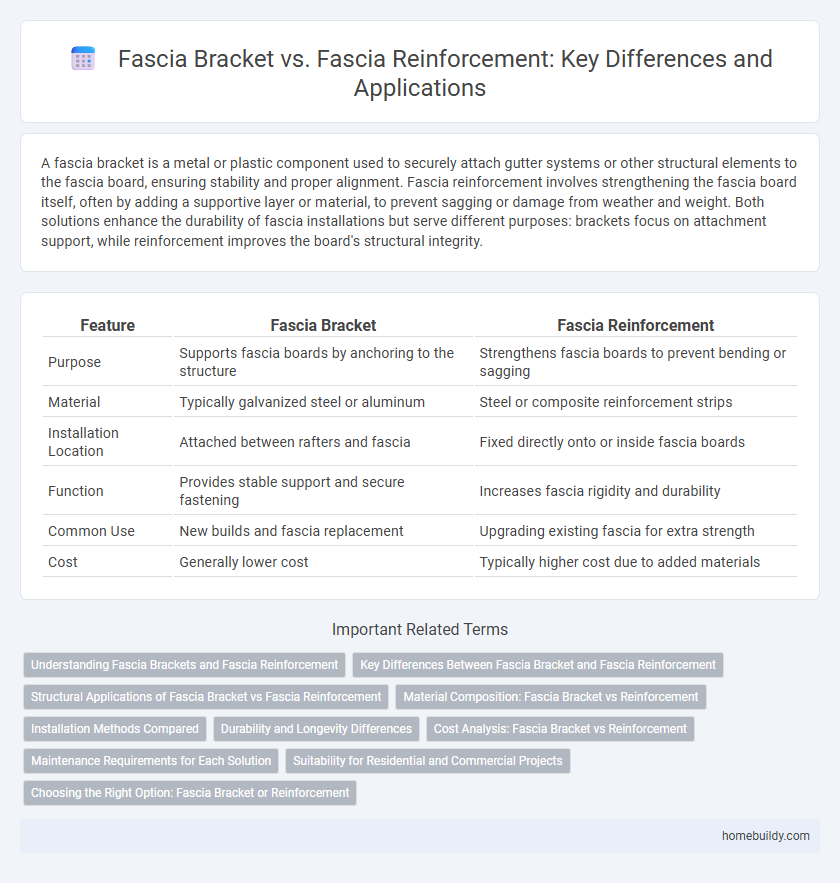A fascia bracket is a metal or plastic component used to securely attach gutter systems or other structural elements to the fascia board, ensuring stability and proper alignment. Fascia reinforcement involves strengthening the fascia board itself, often by adding a supportive layer or material, to prevent sagging or damage from weather and weight. Both solutions enhance the durability of fascia installations but serve different purposes: brackets focus on attachment support, while reinforcement improves the board's structural integrity.
Table of Comparison
| Feature | Fascia Bracket | Fascia Reinforcement |
|---|---|---|
| Purpose | Supports fascia boards by anchoring to the structure | Strengthens fascia boards to prevent bending or sagging |
| Material | Typically galvanized steel or aluminum | Steel or composite reinforcement strips |
| Installation Location | Attached between rafters and fascia | Fixed directly onto or inside fascia boards |
| Function | Provides stable support and secure fastening | Increases fascia rigidity and durability |
| Common Use | New builds and fascia replacement | Upgrading existing fascia for extra strength |
| Cost | Generally lower cost | Typically higher cost due to added materials |
Understanding Fascia Brackets and Fascia Reinforcement
Fascia brackets are metal or plastic supports designed to securely fix fascia boards to a building frame, ensuring stability and preventing sagging. Fascia reinforcement involves strengthening the fascia board itself, often with additional materials or structural enhancements, to enhance durability and weather resistance. Understanding the differences highlights that fascia brackets provide foundational support, while fascia reinforcement improves the board's inherent strength and longevity.
Key Differences Between Fascia Bracket and Fascia Reinforcement
Fascia brackets are metal supports designed to securely attach fascia boards to a building's structure, providing stability and alignment. Fascia reinforcement, on the other hand, involves strengthening existing fascia boards to prevent warping, sagging, or damage caused by weather exposure. The key difference lies in fascia brackets serving as the structural mounting hardware, while fascia reinforcement focuses on enhancing the durability and longevity of the fascia material itself.
Structural Applications of Fascia Bracket vs Fascia Reinforcement
Fascia brackets provide direct, load-bearing support for attaching fascia boards to roof structures, ensuring stability and resistance to wind uplift by anchoring securely to rafters or trusses. Fascia reinforcement primarily involves strengthening existing fascia boards through additional materials or metal strips, improving durability but offering less load distribution compared to brackets. Structural applications favor fascia brackets when robust support and secure fastening are required for heavy cladding or high wind zones, while fascia reinforcement suits maintenance and minor strengthening without altering primary attachment points.
Material Composition: Fascia Bracket vs Reinforcement
Fascia brackets are typically made from high-strength galvanized steel or aluminum alloys designed for durability and corrosion resistance in exterior building applications. In contrast, fascia reinforcements often utilize heavier gauge metals or composite materials to provide enhanced structural support and load-bearing capacity. The material composition of fascia brackets prioritizes flexibility and ease of installation, while reinforcements focus on robustness to maintain fascia integrity under stress.
Installation Methods Compared
Fascia bracket installation typically involves securing metal or plastic brackets directly to the fascia board using screws or nails, providing support for gutter systems with minimal wall penetration. Fascia reinforcement requires embedding additional structural materials like plywood or metal strips behind the fascia, often necessitating partial removal of the fascia for proper attachment and enhanced load-bearing capacity. Compared to fascia brackets, fascia reinforcement offers a more robust installation suited for heavy-duty applications but involves more complex and time-consuming procedures.
Durability and Longevity Differences
Fascia brackets are designed to provide strong, direct support to fascia boards, enhancing overall structural stability and ensuring long-term durability even under heavy loads. Fascia reinforcement typically involves adding material layers or strengthening components to prevent warping and damage, but may not offer the same level of immediate structural support as fascia brackets. The durability of fascia brackets often outperforms fascia reinforcement due to their rigid design, which reduces movement and extends the lifespan of fascia installations.
Cost Analysis: Fascia Bracket vs Reinforcement
Fascia brackets typically offer a lower upfront cost compared to fascia reinforcement due to simpler installation and less material usage. Fascia reinforcement involves additional labor and stronger materials, increasing total expenses but providing enhanced durability for long-term projects. Evaluating project scale and maintenance needs is crucial for cost-effective selection between fascia bracket and reinforcement options.
Maintenance Requirements for Each Solution
Fascia brackets typically require minimal maintenance, as their corrosion-resistant materials and sturdy design reduce the need for frequent inspections or repairs. Fascia reinforcements often demand more regular upkeep due to potential stress points and material fatigue, necessitating periodic checks to prevent structural weakening. Proper selection between fascia bracket and fascia reinforcement depends on balancing initial durability with ongoing maintenance efforts.
Suitability for Residential and Commercial Projects
Fascia brackets provide strong support for gutter installations, making them ideal for both residential and commercial projects requiring durable and weather-resistant solutions. Fascia reinforcement, often used to strengthen the fascia board itself, is best suited for older or weakened structures in residential settings where additional stability is necessary. Commercial projects typically prioritize fascia brackets for their load-bearing capacity and ease of maintenance, ensuring long-term performance under heavy-duty conditions.
Choosing the Right Option: Fascia Bracket or Reinforcement
Choosing the right option between a fascia bracket and fascia reinforcement depends on the structural needs and installation context. Fascia brackets provide reliable support for gutter systems by securely anchoring fascia boards, ideal for straightforward gutter installation. Fascia reinforcement, on the other hand, strengthens damaged or weakened fascia boards, offering a durable solution when durability and long-term stability are priorities.
Fascia bracket vs Fascia reinforcement Infographic

 homebuildy.com
homebuildy.com